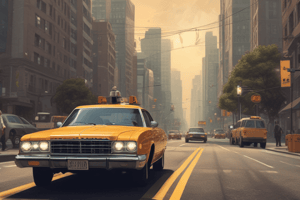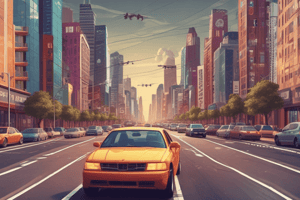Podcast
Questions and Answers
As you are about to enter the vehicle from the street side, you should stand at which part of the vehicle to see approaching traffic?
As you are about to enter the vehicle from the street side, you should stand at which part of the vehicle to see approaching traffic?
- rear
- back
- side
- front (correct)
Before turning left, it is important to:
Before turning left, it is important to:
- Yield to oncoming vehicles (correct)
- Speed up to beat oncoming traffic
- Cut in front of oncoming traffic
- Make a quick turn to get ahead
Why should you come in from the left instead of the usual right?
Why should you come in from the left instead of the usual right?
- Left is for turning
- Right is for merging
- Left is for speed (correct)
- Right is for slowing down
Drivers of trucks shut off their engines and travel with a lot of space in front of their vehicle because they need:
Drivers of trucks shut off their engines and travel with a lot of space in front of their vehicle because they need:
On rural roadways, what is a hazard you should be especially cautious of?
On rural roadways, what is a hazard you should be especially cautious of?
When driving on wet or slippery expressways, how long should your following distance be?
When driving on wet or slippery expressways, how long should your following distance be?
When an emergency vehicle is approaching in heavy traffic, what should you do?
When an emergency vehicle is approaching in heavy traffic, what should you do?
If the accelerator sticks and you need to stop quickly, what should you do first?
If the accelerator sticks and you need to stop quickly, what should you do first?
What is the purpose of crumple zones in a vehicle?
What is the purpose of crumple zones in a vehicle?
What type of line in the middle of a two-lane road indicates that no passing is allowed from either direction?
What type of line in the middle of a two-lane road indicates that no passing is allowed from either direction?
What is the term that describes the area of a vehicle that is engineered to absorb energy in a crash?
What is the term that describes the area of a vehicle that is engineered to absorb energy in a crash?
What is the definition of inertia in the context of driving?
What is the definition of inertia in the context of driving?
What does a flashing yellow arrow in the left turn lane indicate?
What does a flashing yellow arrow in the left turn lane indicate?
What should you do if you encounter a law enforcement officer with their vehicle's emergency flashing lights stopped on the right side of the expressway?
What should you do if you encounter a law enforcement officer with their vehicle's emergency flashing lights stopped on the right side of the expressway?
What is the shape of a school sign?
What is the shape of a school sign?
Are you ever allowed to use the emergency crossover on the expressways?
Are you ever allowed to use the emergency crossover on the expressways?
Flashcards are hidden until you start studying
Study Notes
Vehicle Safety Features
- Crumple zones and side impact panels protect occupants by allowing structures to collapse at different rates, reducing the risk of penetration into the passenger compartment or spreading forces over a wider area.
- Air bags are designed to be used with safety belts.
Crumple Zones
- The crumple zone is a term that describes the area of a vehicle that is engineered to absorb energy in a crash.
Traffic Rules
- A broken yellow line means that passing is allowed when it's clear and safe.
- A double yellow line in the middle of a 2-lane road means no passing either direction.
- A pennant-shaped sign indicates a no-passing zone.
- A solid yellow line next to a broken yellow line means that the vehicles next to the broken line can pass if clear.
- A school sign is yellow-green with 5 sides.
- A traffic light that has been green for some time is stale, and most likely to turn yellow.
Passing and Intersections
- When passing a large truck, it is best to pass on the left.
- Before turning left, it is important to yield to oncoming vehicles.
- If the exit ramp that you intended to use is closed, you should slow down and signal for a lane change.
Speed and Following Distance
- A flashing yellow arrow in the left turn lane allows drivers to slow down and turn if the intersection is clear.
- A flashing yellow turn arrow tells you oncoming through traffic has a green light.
- An advisory speed sign with a speed limit of 35 mph attached just before a curve means 35 mph is the fastest recommended speed under ideal conditions.
- If a driver ahead of you is distracted, you should maintain a safe following distance.
- On wet or slippery roads, you should increase your following distance to at least 4 seconds.
Deer and Rural Roadways
- Driving on rural roadways can be especially hazardous due to deer.
Steering and Stopping
- Hand-over-hand steering involves using the steering wheel down with one hand while the other hand crosses over to pull the wheel farther down.
- To steer straightforward, you should look far ahead towards the center of your intended path.
- If a driver is about to be struck from the rear by another vehicle, you should be ready to apply the brakes so as not to be pushed into another vehicle.
Emergency Vehicles
- If an emergency vehicle is approaching in heavy traffic, if possible, you should move to the right edge of the road and stop.
Accelerator and Brakes
- If the accelerator sticks and you need to stop quickly, you should first apply the brakes and shift to neutral.
Right of Way
- An intersection that has signs or signals to assign the right of way is called a controlled intersection.
Miscellaneous
- Headlights are required to be turned on 30 minutes after sunset and 30 minutes before sunrise.
- If you stop at a red signal light which then changes to green, you should look both ways then go.
- You should never use the emergency crossover on the expressways.
Studying That Suits You
Use AI to generate personalized quizzes and flashcards to suit your learning preferences.




